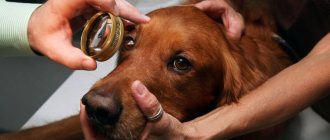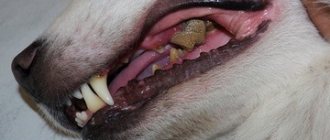The owner needs to fill out an international veterinary passport for dogs not only in connection with traveling abroad, but also to visit exhibitions and transport the pet within the country. A standard document contains detailed information about the owner (full name, address, contact information) and the animal (name, date of birth, breed, brand, special features, etc.), vaccinations and deworming (begin filling out at 2-2, 5 months, after a year a photo is pasted).
If it is available, the procedure for identifying a pet is simplified if it is necessary to prove ownership. If the metric is lost, the owner should contact the veterinary institution where the animal was vaccinated to restore it. The cost of a veterinary passport is from 50 to 150 rubles.
A passport for cats is almost completely identical to a dog passport in terms of information content, filling rules and cost.
How to fill out an international veterinary passport for dogs
It is not difficult to fill out an international veterinary passport for dogs yourself; to do this, you need to carefully and legibly enter the required information in the appropriate columns of the document. Sections that indicate veterinary treatments (deworming, vaccination, etc.) are filled out in a veterinary clinic and certified by the signature and seal of a specialist.
Why do you need a veterinary passport for a dog?
The owner needs a veterinary passport for a dog in the following situations:
- For hassle-free travel in any public transport - taxis, buses, trains, planes, etc.
- In cases where it is necessary to prove ownership of a pet.
- When crossing the external borders of the country (leaving for permanent residence, on vacation, on a business trip, to an exhibition, etc.).
- Participation in various exhibition events associated with the presence of other animals.
- In order to track antiparasitic treatments and vaccination schedule.
- Participation in the work of breeding and improving breed qualities.
Example of a completed passport
According to current legislation, the owner of an animal is not required to present a veterinary passport when traveling with a pet within the country . However, experienced dog breeders recommend taking this document with you on a trip to avoid unpleasant situations.
How to get a passport for a dog
The owner can obtain a passport for a dog by contacting a veterinary clinic. This issue is often dealt with by the breeder from whom the puppy is purchased. At the age of 2-2.5 months, a note is placed in the document about deworming and the first vaccination of the pet. You can purchase dog metrics not only at a specialized institution, but also at a pet store.
We recommend reading about how to transport a dog. From the article you will learn about the general rules for transporting dogs, transporting a pet in a car, plane, bus and train.
And here is more information about the rules for transporting a dog in a car.
What does a dog's passport, international vaccination certificate look like?
A dog's passport looks like a small book in which the pages are divided into columns and lines. In the international document, names in Russian are duplicated in English. On the first page of the metric there is a place for pasting a photograph of the pet and lines in which data about the owner is entered - last name, first name, patronymic, place of residence, contact information. The international document contains a column that reflects information about the breeder.
As for data about the animal, the veterinary passport must indicate the name, date of birth, and breed. The document contains lines that include the animal’s gender, information about castration, color, and special features. After the dog turns 1 year old, a photograph is pasted into the document.
How to fill out an international dog passport
Separate columns in the metric contain data that allows you to identify a pet - brand, pedigree number, information about the microchip. As for information about microchipping, this section includes information about the date of the procedure and its location. A barcode is attached to the page, which confirms the fact of microchipping and completely replicates the data of the microchip implanted in the pet’s body.
The International Vaccination Certificate contains information regarding veterinary treatments performed. The document indicates the dates and drugs used for deworming before vaccination. On specially designated pages, information about the routine vaccination is entered - the date of vaccination, the name, series and number of the vaccine, the signature of a veterinary specialist and the seal of the institution where the procedure was carried out.
Watch this video on how to fill out an international passport for a dog:
Gender of the dog in the passport: how to indicate
To indicate the gender of the dog in the passport, you must select a Latin designation: the male gender (male) is designated in veterinary metrics by the letter M (male), and the female gender (bitch) by the letter F (female). As a rule, in the document, the gender is marked with a tick in the box opposite the letter M or F. In addition to the gender, information about the castration (sterilization) of the animal is also entered.
Information about the pet’s gender, like other data, is entered into the document in legible handwriting and block letters.
Is data on deworming treatment included in the puppy passport?
The puppy passport, which is filled out by the breeder, contains information about deworming. Such data is necessary for a veterinarian to plan the first vaccinations and create a schedule for subsequent treatments. Information about the date of the antiparasitic procedure and the name of the drug is entered in the appropriate columns.
How long is a dog passport valid?
A dog passport is issued for an animal once and is valid for the entire life of the pet. An international document has no expiration date and, if lost, is subject to mandatory restoration.
Where to get a dog passport
You can get a dog passport at a pet store, a specialized clinic, or from a breeder. However, without the appropriate marks, signatures and seals, the metric will not be valid.
How much does it cost to get a passport for a dog?
Making a dog passport is inexpensive - the book itself with the necessary pages costs from 50 to 150 rubles, depending on the quality of the cover and design. Notes on deworming and vaccination are provided by a veterinarian free of charge.
What information about the dog must be indicated in the document?
Nowhere is it stipulated what specific information should be included in the document and how to fill out a veterinary passport for a dog. But there are standard forms that usually include the following fields:
- details of the animal owner (full name, address, telephone number);
- information about the pet (photo, age, breed, color, special features, number, date and place of installation of the chip);
- information about vaccinations, medical treatments, operations;
- information about offspring.
Data on vaccinations contain the names and series of vaccines and drugs administered, their expiration dates and dates of vaccination. When specifying information about microchipping, it is more convenient to use a special sticker with the chip number rather than filling out the information manually.
The electronic chip, located inside a small capsule, is injected subcutaneously into the withers area using a disposable syringe. The size of the chip is very small, so the procedure does not cause pain in the dog, and the chip itself does not cause problems for the animal in the future. The chip code cannot be changed; it can be used to identify an animal in any country. The information is read using a special device.
For your information! In many countries, vaccinations and medical treatments performed only after the chip has been installed are taken into account. All interventions that were performed previously are not taken into account.
All sections of the passport are filled out with a blue or black pen in two languages - Russian and English.
To freely leave the country with your pet, you must fill out the document correctly.
The “Breed” section is filled out according to the information from the animal’s card or metric received from the nursery (breeder). For example, outbred animals are recorded as half-breed (mixed breed).
Gender of the dog in the passport: how to indicate
In some sections, it is enough to enter one character. The “Gender / Sex” field is filled in as follows:
- male - male (M);
- female - female (F).
Information about vaccination and deworming
This is the most important section of the veterinary passport. It must be filled out in as much detail as possible, because records of vaccinations and other medical interventions are paid attention to even when transporting a pet across the country. Some countries attach importance to certification of the administered vaccine. Therefore, it is advisable that the vaccination record be accompanied by a special sticker with the number and other information about the vaccine.
Information on vaccinations is certified by the signature of a veterinarian and the seal of a medical institution
Basic vaccines and procedures, information about which is included in the section:
- rabies test. This is especially true for dogs that are taken hunting with them. Not required for domestic travel. But entering some countries with a dog, cat or ferret is impossible without this research. The test is done in laboratories that have passed state accreditation. The study is carried out one month after vaccination. The result is valid for 3 months;
- operations (including sterilization). The date and name of the doctor who performed the procedure is recorded;
- deworming, tick and flea treatment. The date of the procedure, the name of the medicine, and the dosage of the medicine are indicated. Additionally, attach a sticker to the drug label. When processing independently, the owner can enter information into the passport himself. In this case, you must contact the clinic so that the veterinarian examines the pet and certifies the record with a seal and signature;
- vaccination. The date of vaccination, the name and number of the vaccine, and the sticker from the label of the ampoule with the drug are recorded.
For your information! For females who have given birth, the dates of estrus, mating and birth, and the number of babies born are also indicated.
Veterinary passport for a cat
A veterinary passport for a cat is practically no different from the metric for dogs; the document reflects information about the owner and animal, data on the veterinary procedures performed.
Why do you need a passport for a cat for transportation?
The owner should obtain a passport for a cat for transportation for the following reasons:
- When traveling outside the country. Crossing the border with an animal requires compliance with certain norms of international veterinary legislation.
- Participation in exhibition events. Having a veterinary passport is necessary for admitting a pet to fairs and exhibitions and is a guarantee that the animal is vaccinated, treated against parasites and does not pose an epidemiological threat to its relatives.
How to make a passport for a cat
It’s easy to make a passport for a cat: you need to purchase a special booklet and enter the necessary information. You can get it from a breeder or get it from a veterinary clinic.
Filling out a veterinary passport for cats: what should be indicated
Filling out a veterinary passport for cats should begin with information about the owner and breeder (if this is an international document). In the metric, in addition to the surname and initials, they indicate the place of residence and contacts of the owner.
In the appropriate columns about the animal, information about the name, breed, date of birth, special features of the animal is entered, the gender is indicated, whether the pet is neutered or not. Particular attention should be paid to the correct indication of the color of the animal and the nature of the coat. Separately, fill out information about whether the cat has a microchip.
How to make a kitten passport for identification
To make a passport for a kitten for identification purposes, an international document of the established form is used. As a rule, a mark and microchip are required when transporting a pet outside the country. In this case, immediately after the procedure for assigning an identification number in a specialized institution, information about the microchip is entered into the veterinary passport and duplicated with a sticker with a barcode for reading the data.
Veterinary passport for a cat with vaccinations
A veterinary passport for a cat with vaccinations is necessary not only for unhindered travel around the country and abroad, but also for monitoring the health of the animal. The document reflects vaccinations and deworming.
How to make a passport for a cat's breed
A passport for a cat’s breed is not specially made. The veterinary record includes information about what breed the animal belongs to. The owner can confirm that he belongs to a particular breed at an exhibition. In this case, the animal is issued a certificate of conformity. This document is necessary for breeding work, drawing up a mating certificate, and selling kittens from titled parents.
Registration and re-registration of a cat's passport
The cat's passport is registered or re-registered (if lost) at a veterinary clinic. The owner of the animal is responsible for the information included in the document.
How much does a veterinary passport cost for a cat?
A veterinary passport for a cat costs the same as for a dog - on average about 100 rubles. The cost of a book with numbered pages depends on the quality of the cover.
How and where to get a veterinary passport
A veterinary passport can only be issued at the veterinary clinic where the pet is being treated. It can be a public or private hospital, the document form is the same everywhere. This rule is observed especially strictly if an international passport is needed. If a dog changes owner, all its documents move with it.
How and when to obtain a veterinary passport for a pet:
- If a breeder has puppies, he processes their paperwork within the first month. This is usually done in conjunction with vaccinations. By the time the time comes to distribute the puppies, all formalities must be completed.
- The new owner receives documents from the breeder and registers them at his place of residence.
- An adult dog must have all the vaccinations required by its age, or provide proof that they have been given.
- If the animal was picked up from the street, this must be indicated. Responsible owners begin acquaintance with a new family member with a visit to the veterinarian, treatments for parasites, vaccinations and paperwork.
It is much easier to obtain a correct veterinary passport for a puppy than for an adult dog. New data and current information are constantly being added to it.
Before registration you need to be treated for fleas
Is it necessary to obtain passports for animals?
It is mandatory to obtain a pet passport in cases where the pet crosses the border of the country. Without this document, executed accordingly, neither a cat nor a dog will be allowed through veterinary control at customs.
If you do not plan to travel abroad, then it is not necessary to issue an international document, but the animal must have a veterinary passport. Its presence will allow you to freely travel within the country, attend exhibitions and other events.
What information is included in a dog’s veterinary passport?
The passport contains as much information as possible about the animal and its owner. Part of the column is filled in by the owner, part by the veterinarian at the clinic.
Owner details
On the first page, in addition to general information, information about the owner is usually indicated: full name, age, residential address, telephone number. This is necessary to confirm ownership of the dog, as well as in cases where the pet escapes.
Dog information
Enter the following information regarding your furry friend:
nickname in full, as in the metric (if there is one);
date of birth (if a foundling, then approximate);
coat color and type;
number and location of the mark;
after receiving the pedigree - its number;
If desired, you can indicate special features of your pet - information about sterilization, chronic diseases, eye color, etc.
Information about vaccination and deworming
In this section, a record of the vaccination is not simply entered, but a sticker is pasted with the name of the drug, its series and number, after which all data is certified by the seal and signature of the doctor who performed the procedure.
The owner can paste stickers from anthelmintic tablets on his own, as well as write down when flea and tick treatment was carried out. If information about deworming is needed for travel, then it is also certified by a veterinarian.
Information about matings
Separate documentation is drawn up for planned matings, but if you wish, you can fill out information about the matings: the date of the main and control matings, the name of the partner, the duration of pregnancy, the date of birth and the number of puppies. The veterinarian can enter some details about the birth, such as caesarean section, duration, complications, etc.
How to make a passport for a dog or cat if the previous one is lost
A veterinarian will help you get a passport for your dog or cat if the document is lost. To do this, the owner must contact a specialized institution where the pet was vaccinated. Based on the accounts, the animal’s veterinary passport will be restored. This procedure is free. The owner will only have to pay for the purchase of the booklet itself.
We recommend reading about what vaccinations are given to cats. From the article you will learn about what vaccinations cats should have, vaccinations for traveling abroad, and types of vaccines.
And here is more information about how to transport a cat on a train.
The veterinary passport of a dog or cat is the main document required for transporting animals by public transport. Without it, veterinary customs control will not give permission to cross the border. The document of the established form must contain the necessary notes on vaccinations against rabies and other infectious diseases. If you lose your passport, you can restore it by contacting a veterinary institution.
What is an international veterinary passport?
A veterinary passport is the main document for a pet. It contains data about the owner and his pet, information about veterinary treatments. The minimum required information is information about rabies vaccinations. The veterinarian fills out all fields.
An international passport may look different
For your information! A distinctive feature of an international passport compared to an internal document is the repetition of information in English.
The document is needed for pets going on a trip. Based on it, other certificates necessary for crossing the border are issued, including a veterinary certificate in Form No. 1. It is issued in state-licensed veterinary clinics one month after the rabies vaccination.
Important! Certificate FNo. 1 is valid for 5 days.
Also, some countries additionally require a certificate with a translation of vaccination information into the official language of the destination.
Useful video
Watch this video about what an international veterinary passport looks like and what it is needed for:
Similar articles
- How to transport a dog in transport: on an airplane, on a train...
When traveling abroad, you must obtain an international veterinary passport, a state veterinary passport... Quite often, the owner of a four-legged family member is faced with the task of how to transport a dog. A visit due to an illness or for preventive purposes... Read more - Microchipping of dogs, cats: what is it for, the law...
Dogs are microchipped only in big cities. ... The radio frequency device is installed according to the international standard and can be read ... In addition, they are required to be reflected in the veterinary passport. Read more
- Transporting a dog in a car: travel rules...
When crossing the border, you must have an international veterinary passport. ... The disadvantage of the crate is that the dog’s movements are constrained; therefore, for long journeys, such a remedy... Read more
- How to transport a cat on a train, how to transport a cat across Russia...
When traveling long distances, you should plan in advance how to transport your cat on the train. After all, you need to take your cat in a carrier, and even when traveling around Russia, vaccinations and a veterinary passport are required. Read more
- Protective collar for dogs: how to make your own...
A protective collar for dogs after surgery or during ear treatment will come in handy. It is important to choose the right size, as well as the type - soft, inflatable. For thrifty owners, you can do it yourself. It should be worn during the game. Read more











